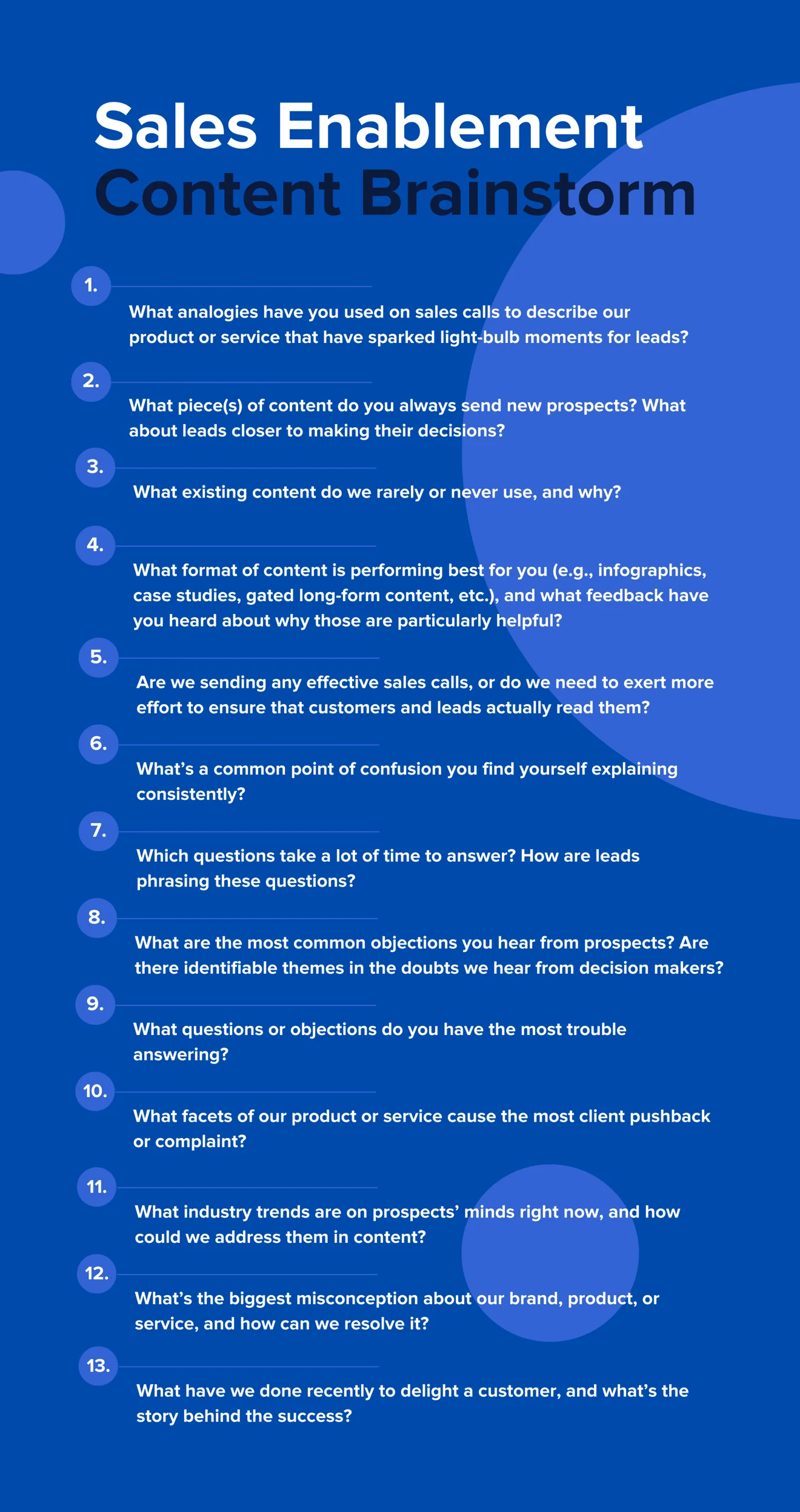
How to Brainstorm Sales Enablement Content Topics
How to Brainstorm Sales Enablement Content Topics
Alyssa Patzius, VP of Sales • Intero Digital • May 25, 2022

Sales and marketing teams are increasingly on the same page about needing content marketing for sales enablement, given that it’s been shown to lead prospects deeper into their buyer journeys and make sales representatives more effective overall. The average B2B buyer is said to read about 13 pieces of content before making a purchase decision, so it’s essential for sales teams to be ready to deploy relevant content at the perfect moment.
But challenges in creating effective sales enablement content continue to bedevil marketing teams. For one thing, the feeling of churning out cookie-cutter content runs rampant among marketing leaders and content creators: Only 12% of respondents in a Content Marketing Institute survey said they felt their sales content was very or extremely different from what their competitors were sharing. And in terms of content quality, 61% said the content they’re creating is promotional rather than educational, with only 31% saying their content is typically thought leadership separate from the product or brand.
The same survey revealed that while most marketing leaders said their sales and marketing teams work together on content topics, they’re not frequently collaborating on what types of content they should be producing and therefore aren’t creating the varieties that could be most helpful. On top of that, 57% of respondents said they rarely or never assess the content’s effectiveness using the same sales enablement KPIs, so they aren’t sure whether they’re moving the needle at all.
Many of these problems can be ameliorated with thoughtful sales and marketing alignment that ensures the marketing team is producing valuable educational materials and the sales team is actually using the content. That alignment starts with an effective system for content brainstorming. Below, we’ll walk through a process for brainstorming high-quality sales enablement topics that reps can use to educate prospects and bring in more sales.
How to Brainstorm Valuable Sales Enablement Content Ideas
Before you begin to set sales enablement goals and execute toward them, it’s important to revisit what sales enablement content can accomplish. Effective sales enablement content can serve multiple purposes: It should help sales reps overcome common objectives that arise during sales calls; teach prospects the essentials about your company and its processes, plus what kind of ROI they should expect; get your prospects ready to become great customers; and offer valuable information that prospects’ teams will need in order to make purchasing decisions.
So the question is, how can companies brainstorm the most valuable topics from a sales enablement standpoint? Follow these tips for generating topic ideas that will arm your sales team with the sales enablement content they need:
1. Set recurring brainstorming meetings with sales and marketing.
The first step in brainstorming is gathering all the right brains to work together, so if your marketing team has been setting content priorities for sales enablement without the sales team’s input, it’s time to reset your process and loop in the right people.
Get your team’s revenue-generating crew (including sales, marketing, and any other roles responsible for bringing home the bacon) together with your content team (any creators of marketing content for your business) for a regular discussion of the sales pipeline, prospects, and future content topics that will satisfy leads’ needs. Set a recurring invitation on the calendar for brainstorms to occur at a regular interval. That might be weekly, biweekly, monthly, or quarterly, depending on your existing content bank and the depth of your needs.
2. Encourage everyone to prepare ahead of time.
Appoint a moderator to ensure the brainstorm is organized and effective. The moderator can own the calendar invite, set a content theme to brainstorm around, collect questions the sales team is hearing most often, manage the brainstorm agenda, and direct the brainstorming conversation to uncover insights that will yield the best fodder for content. Though a brainstorm is always collaborative by nature, it benefits from a pacesetter who can ensure the team touches on a variety of ideas that they can later refine.
The moderator can also lay out a plan to ensure everyone prepares for their roles in the brainstorm. This communication can include sending out questions to think through in advance, asking people to fill out a brainstorming agenda with experience-share information, reviewing recent sales calls for ideas that could’ve been explained better, tasking the relevant people to pull any necessary data on past content performance from your shared CRM, or analyzing successful competitor content. The moderator can remind the team members at least 24 hours before the brainstorm about the information or starting ideas they’re responsible for bringing.
3. Ask and answer questions to get the juices flowing.
Once the team is assembled at the brainstorm, embrace a curiosity-based mindset that focuses on asking and answering questions like, “What if …?” or “How might we …?” and coming up with possible answers. Instead of rejecting any ideas, ask follow-up questions to hone them further.
When brainstorming sales enablement content ideas, our team has ideated successful topics by asking ourselves (and one another) questions like these:

The list of possible questions is long and varied, and the best questions for your team could include variations on those above that are more tailored to your business. For example, a B2B service organization will likely be fielding a lot of inquiries about process, while a B2C product might be hearing mostly about efficacy and price. The main idea is to get your sales representatives and your marketing team on the same page about the sales team’s challenges and wins to produce valuable sales enablement content ideas.
4. Document all ideas generated and requested.
One key element of brainstorming is capturing all thoughts and discussions on topics — good, bad, or merely decent — because they can always serve as springboards for future content. When you brainstorm, document the ideas generated during the meeting by making sure to record the audio, enlisting a diligent notetaker, asking brainstormers to contribute via a collaborative whiteboard tool, or via some combination of strategies.
It may also be helpful to create a process for the sales team to request content ideas from the marketing team between brainstorming sessions. This could be as simple as a spreadsheet or Google Form that collects information on the question or objection to answer, the desired format for the content, a desired subject matter expert for bylining the piece if applicable, and any context around why the content is needed (i.e., how it could help secure sales).
Additionally, keep a tracking sheet of all the content already created, what topics are next in your editorial calendar, and how the potential topics and themes fit into the company’s documented content strategy. That can serve as a reference point during your brainstorming so the team doesn’t closely duplicate content that’s already performing well but instead can cross-reference to see what content is due for an update versus what should be created from scratch.
Plenty of Ideas: Now What?
Once the brainstorming team has come up with topic ideas, it’s best to get a sense of which are most pressing, which should be prioritized for creation before the next brainstorm, and which could hold for a quarter or two. The team should update its content strategy to reflect the direction determined during the brainstorm session.
The next step is our favorite: creating sales enablement content that generates responses from leads and brings in new sales.
